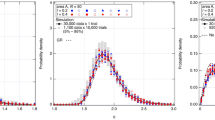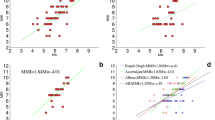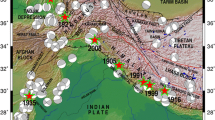Abstract
A new criterion is introduced to judge if the vicinity of the source region of a great interplate earthquake is in an ‘active period’. It is based on the stress change caused by the great earthquake. A region is regarded as being in an active period of seismicity if the occurrence rate of earthquakes on faults in the stress shadow of the great earthquake is significantly higher than in the early stage of the seismic cycle, and if the stressing rate of these faults is sufficiently low. This criterion was applied to the seismicity in the central part of southwest Japan before and after the 1944 Tonankai and 1946 Nankai earthquakes. The results show that before the 1944 Tonankai earthquake, the region was in an active period from at least 1927.The region was in a quiet period for almost50 years after the 1946 Nankai earthquake.Data after 1995 show that the region is once more in an active period of seismicity preceding the next great interplate earthquakes along the Nankai trough,although the total number of earthquakes has not yet significantly increased. Our results indicate that earthquake probability in the central part of southwest Japan will become high in the coming decades until the next great interplate earthquakes along the Nankai trough.
Similar content being viewed by others
References
Aida, I., 1981a, Numerical experiments of historical tsunamis generated off the coast of the Tokaido district, Bull. Earthq. Res. Inst. 56, 367–390 (in Japanese with English abstract).
Aida, I., 1981b, Numerical experiments for the tsunamis generated off the coast of the Nankaido district, Bull. Earthq. Res. Inst. 56, 713–730 (in Japanese with English abstract).
Bowman, D.D., Ouillonk, C.G. Sammis, A. Sornette and Sornette, D., 1998, An observational test of the critical earthquake concept, J. Geophys. Res. 103, 24359–24372.
Ellsworth, W.L., Lindh, A.G., Prescott, W.H. and Herd, D.G., 1981, The 1906 San Francisco earthquake and the seismic cycle, In: Simpson, D.W. and Richards, P.G. (eds.), Earthquake Prediction: An International Review, AGU, Washington, D.C., pp. 126–140.
Harris, R.A., 1998, Introduction to special session: Stress triggers, stress shadows, and implications for seismic hazard, J. Geophys. Res. 103, 24347–24358.
Harris, R.A. and Simpson, R.W., 1996, In the shadow of 1857 — The effect of the great Ft. Tejon earthquake on subsequent earthquakes in southern California, Geophys. Res. Lett. 23, 229–232.
Harris, R.A. and Simpson, R.W., 1998, Suppression of large earthquakes by stress shadows: A comparison of Coulomb and rete-and-state failure, J. Geophys. Res. 103, 24439–24451.
Hori, T. and Kaneda, Y., 2001, A simple explanation for the occurrence of the 1911 Morgan Hill earthquake in the stress shadow of the 1906 San Francisco earthquake, Geophys. Res. Lett. 28, 2261–2264.
Hori, T. and Oike, K., 1996, A statistical model of temporal variation of seismicity in the Inner Zone of Southwest Japan related to the great interplate earthquakes along the Nankai trough, J. Phys. Earth 44, 349–356.
Hori, T. and Oike, K., 1999, A physical mechanism for temporal variation in seismicity in Southwest Japan related to the great interplate earthquakes along the Nankai trough, Tectonophys. 308, 83–98.
Ichikawa, M., 1971, Reanalyses of mechanism of earthquakes which occurred in and near Japan, and statistical studies on the nodal plane solutions obtained, 1926–1968, Geophys. Mag. 35, 207–274.
Ichikawa, M., 1979, Some problems in the focal mechanism in and near Japan, Geophys Mag. 39, 1–24.
Iio, Y., 1997, Frictional coefficient on faults in a seismogenic region inferred from earthquake mechanism solutions, J. Geophys. Res. 102, 5403–5412.
Kanamori, H., 1972, Determination of effective tectonic stress associated with earthquake faulting. The Tottori earthquake of 1943, Phys. Earth Planet. Inter. 5, 426–434.
Kanamori, H., 1973, Mode of strain release associated with major earthquakes in Japan, Ann. Rev. Earth Planet. Sci. 1, 213–239.
Mogi, K., 1981, Seismicity in western Japan and long-term earthquake forecasting. In: Simpson, D.W. and Richards, P.G. (eds.), Earthquake Prediction: An International Review, AGU, Washington, D.C., pp. 43–51.
Oike, K., 1995, Seismogenic Island Arc in the Active Period of Seismicity (Iwanami Library of Science, 33), Iwanami, Tokyo, in Japanese.
Okada, Y., 1992, Internal deformation due to shear and tensile faults in a half-space, Bull. Seism. Soc. Am. 82, 1018–1040.
Sagiya, T. and Thatcher, W., 1999, Coseismic slip resolution along a plate boundary megathrust: The Nankai Trough, southwest Japan, J. Geophys. Res. 104, 1111–1129.
Sangawa, A., 1999, Archaeological evidences of strong ground motion in the past 2000 years, Chikyu Monthly 24 (extra), 56–63, in Japanese.
Shimazaki, K., 1976, Intra-plate seismicity and inter-plate earthquakes: historical activity in Southwest Japan, Tectonophys. 33, 33–42.
Shimazaki, K., 1978, Correlation between intraplate seismicity and interplate earthquakes in Tohoku, northeast Japan, Bull. Seism. Soc. Am. 68, 181–192.
Simpson, R.W. and Reasenberg, P.A., 1994, Earthquake-induced static stress changes on central California faults, In: Simpson, R.W. (ed.), The Loma Prieta, California, Earthquake of October 17, 1989-Tectonic Processes and Models, U.S. Geol. Surv. Prof. Pap. 1550.-F, F55–F89.
The Research Group for Active Faults of Japan, 1991, Active Faults in Japan (revised ed.) Univ. Tokyo Press, Tokyo.
Utsu, T., 1982, Catalog of large earthquakes in the region of Japan from 1885 through 1980, Bull. Earthq. Res. Inst., Univ. Tokyo 57, 401–463, in Japanese with English abstract.
Wessel, P., and Smith, W.H.F., 1991, Free software helps map and display data, EOS Trans. 72, 441.
Working Group on California Earthquake Probabilities, 1999, Earthquake Probabilities in the San Francisco Bay Region: 2000 to 2030 — A Summary of Findings, U.S. Geological Survey Open-File Report, pp. 99–517.
Author information
Authors and Affiliations
Rights and permissions
About this article
Cite this article
Hori, T., Kaneda, Y. Physical criterion to evaluate seismic activity associated with the seismic cycle of great interplate earthquakes. Journal of Seismology 8, 225–233 (2004). https://doi.org/10.1023/B:JOSE.0000021364.93301.2a
Issue Date:
DOI: https://doi.org/10.1023/B:JOSE.0000021364.93301.2a




